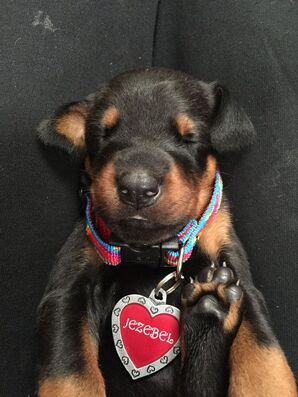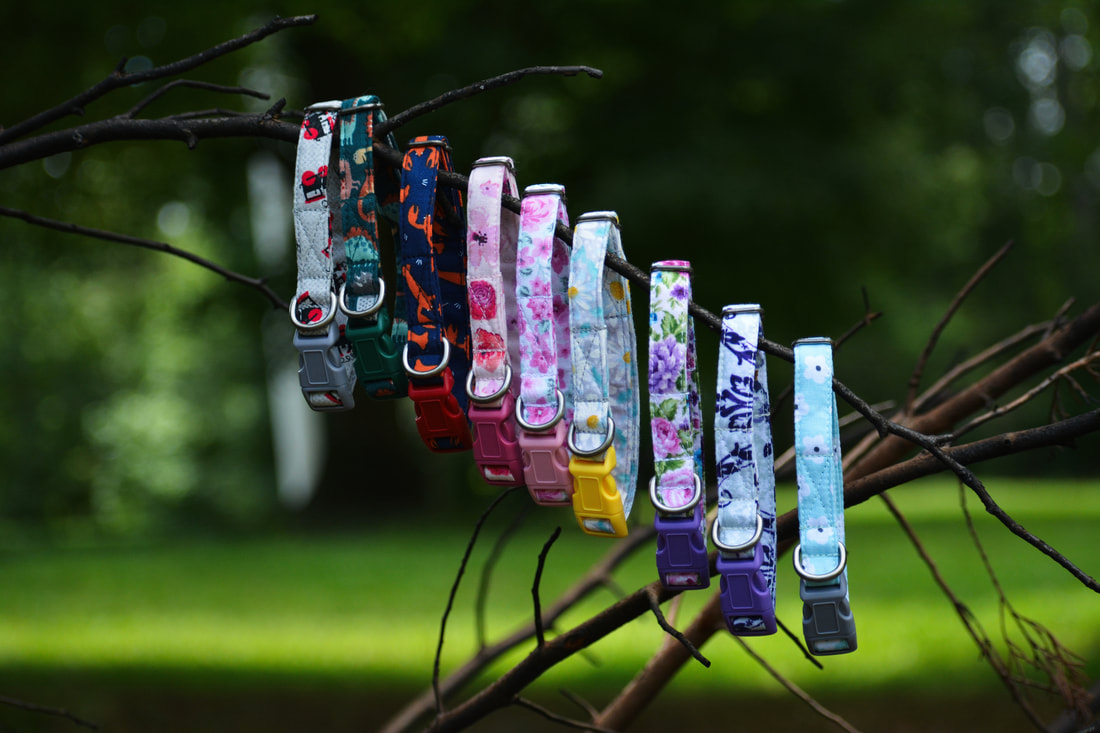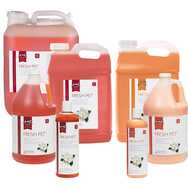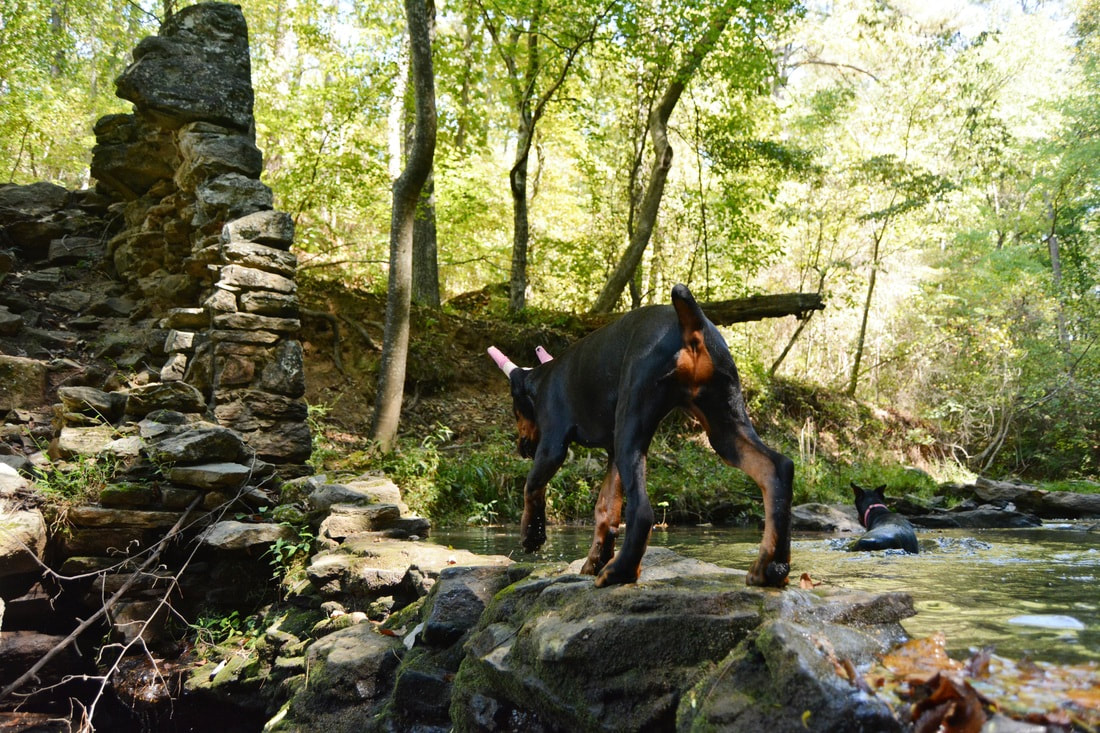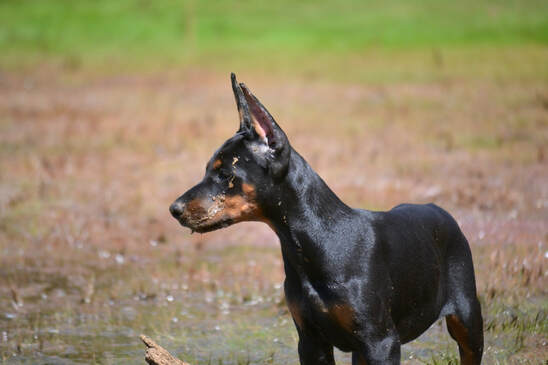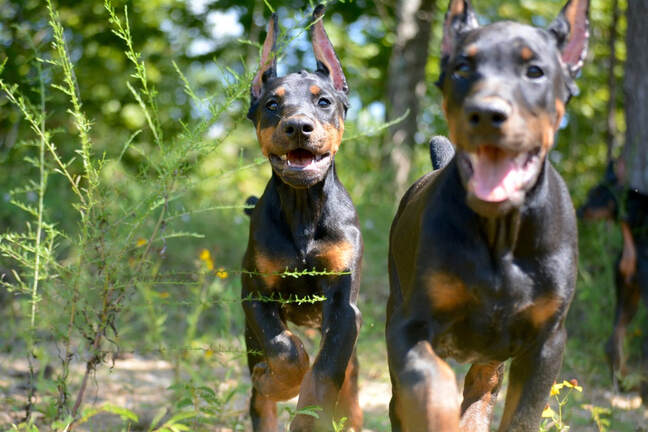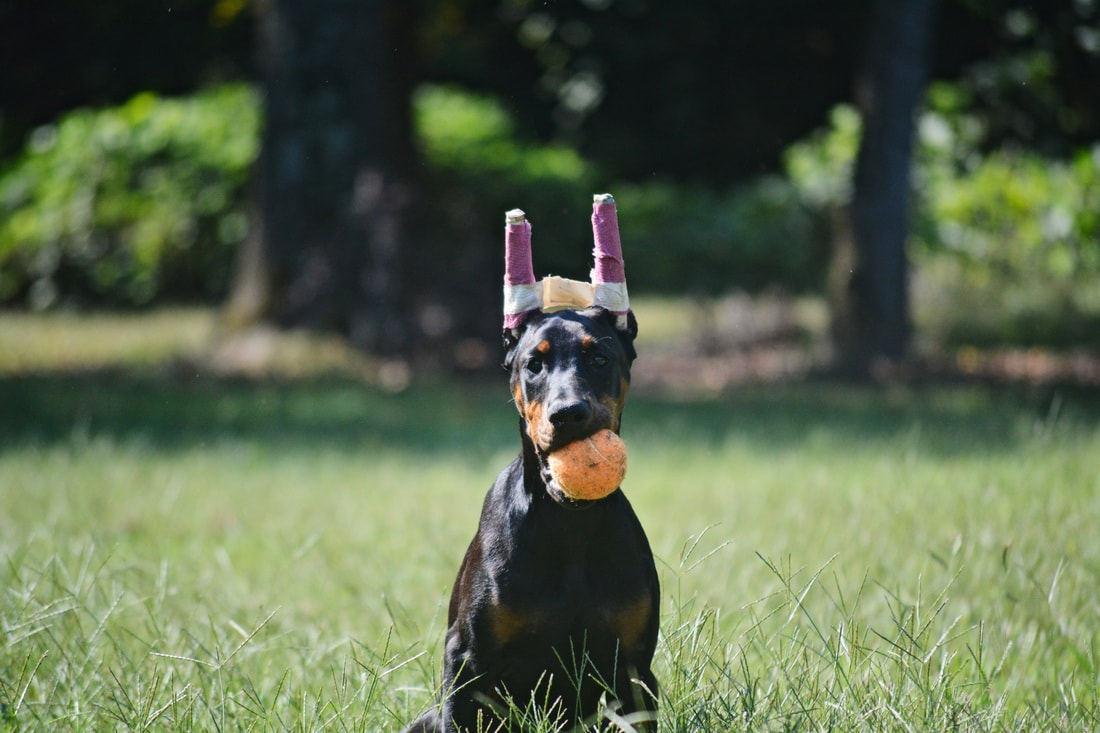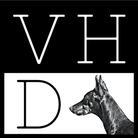Preparing for a Doberman Puppy
Congratulations on the upcoming addition to your family!
Preparing for a European Doberman puppy can be an exceptionally fun time for the entire family, but it can also be overwhelming. Between thinking about every item your newest little one will need to grow up and thrive in addition to the long list of things needed to be completed to prepare, stress can start to creep in.
To make the preparation and transition a little easier, we have made a comprehensive list of our recommendations for both supplies as well as items to check off your to-do list before picking up your puppy!
Preparing for a European Doberman puppy can be an exceptionally fun time for the entire family, but it can also be overwhelming. Between thinking about every item your newest little one will need to grow up and thrive in addition to the long list of things needed to be completed to prepare, stress can start to creep in.
To make the preparation and transition a little easier, we have made a comprehensive list of our recommendations for both supplies as well as items to check off your to-do list before picking up your puppy!
Supplies
In preparation for your Doberman puppy, we recommend obtaining the following supplies:
Crate
We recommend purchasing a crate to both crate-train and potty-train your puppy.
Initially, we recommend the 200 series crate (28" Length x 20.5" Width x 21.5" Height) for when your puppy comes home. For adults, we recommend the 500 series crate (40" Length x 27" Width x 30" Height) for females and the 700 series crate (48" Length x 32" Width x 35" Height) for males.
We recommend airline-approved crates over the wire crates as they are more secure. In the past, we have found crates to be cheapest on Amazon, but shop around online for the best deal.
Initially, we recommend the 200 series crate (28" Length x 20.5" Width x 21.5" Height) for when your puppy comes home. For adults, we recommend the 500 series crate (40" Length x 27" Width x 30" Height) for females and the 700 series crate (48" Length x 32" Width x 35" Height) for males.
We recommend airline-approved crates over the wire crates as they are more secure. In the past, we have found crates to be cheapest on Amazon, but shop around online for the best deal.
Food
Please contact us to find out what your puppy is currently being fed. If you have a different diet in mind, please let us know!
Treats
We recommend having small, bite sized, training treats to use as rewards for your puppy as you start your training program. You can use individual pieces of kibble as treats as well.
We like to have a variety of treats on hand. Our favorites are "Lamb Lung Training Treats" by Merrick (can be purchased on Amazon or Chewy) and Zuke's "Mini Naturals Salmon Recipe Dog Treats" by Zuke (can be purchased on Chewy).
We like to have a variety of treats on hand. Our favorites are "Lamb Lung Training Treats" by Merrick (can be purchased on Amazon or Chewy) and Zuke's "Mini Naturals Salmon Recipe Dog Treats" by Zuke (can be purchased on Chewy).
Toys & Chews

We recommend having a variety of toys and chews to keep your puppy busy as well as helping with the bite inhibition training.
Stuffed and rope toys can be used when the puppy is young, but once these start getting destroyed and become a safety concern, we recommend transitioning to safer and tougher toys.
Our puppies & dogs love the traditional rubber "Kong" toys. We recommend the medium size for our puppies, the X-Large for females, and XX-Large for males. We stuff our dogs' with peanut butter (check your peanut butter to make sure it does not contain aspartame as this is toxic to dogs). "Kong" toys can be purchased at any local pet store or online at Chewy or Amazon. Please note that "Kong" toys are not indestructible and can break into pieces with heavy chewers. We recommend supervising your puppy with any toy as a safety precaution.
We also recommend the "Bounce and Play" by Jolly Pets in the 8-inch variety. We have had our original Jolly Ball for almost 5-years (without it being destroyed). It is about the size of a soccer ball, can be thrown or kicked for fetch and chewed on by heavy chewers, and is our Novella's favorite toy. Jolly Balls can be purchased online at Chewy or Amazon.
Another recommendation is the "Sport Launcher Ball Thrower" by Chuckit!. We use this stick to play fetch with our Jezebel as it allows us to throw the ball a further distance. Chuckit! launchers can be purchased online at Chewy or Amazon.
For chews, we recommend Bully Sticks (not rawhides), we purchase ours in bulk from Best Bully Sticks. Ears, tendons, and tracheas are also good chews to have for variety, but they do not last as long as Bully Sticks. A large, raw bone can be an excellent treat if supervised. We do not recommend giving processed (smoked, cured, dried, etc.) bones as they can splinter and are often too small.
With any toy or chew, always supervise your puppy to make sure s/he remains safe!
Stuffed and rope toys can be used when the puppy is young, but once these start getting destroyed and become a safety concern, we recommend transitioning to safer and tougher toys.
Our puppies & dogs love the traditional rubber "Kong" toys. We recommend the medium size for our puppies, the X-Large for females, and XX-Large for males. We stuff our dogs' with peanut butter (check your peanut butter to make sure it does not contain aspartame as this is toxic to dogs). "Kong" toys can be purchased at any local pet store or online at Chewy or Amazon. Please note that "Kong" toys are not indestructible and can break into pieces with heavy chewers. We recommend supervising your puppy with any toy as a safety precaution.
We also recommend the "Bounce and Play" by Jolly Pets in the 8-inch variety. We have had our original Jolly Ball for almost 5-years (without it being destroyed). It is about the size of a soccer ball, can be thrown or kicked for fetch and chewed on by heavy chewers, and is our Novella's favorite toy. Jolly Balls can be purchased online at Chewy or Amazon.
Another recommendation is the "Sport Launcher Ball Thrower" by Chuckit!. We use this stick to play fetch with our Jezebel as it allows us to throw the ball a further distance. Chuckit! launchers can be purchased online at Chewy or Amazon.
For chews, we recommend Bully Sticks (not rawhides), we purchase ours in bulk from Best Bully Sticks. Ears, tendons, and tracheas are also good chews to have for variety, but they do not last as long as Bully Sticks. A large, raw bone can be an excellent treat if supervised. We do not recommend giving processed (smoked, cured, dried, etc.) bones as they can splinter and are often too small.
With any toy or chew, always supervise your puppy to make sure s/he remains safe!
Walking Supplies - Collar, Leash, Harness, & Identification Tags
|
We recommend purchasing identification tags if you have selected your puppy's name prior to pick-up. Tags can be purchased at your local pet store - this makes for a great outing to start feeling excited about your puppy! Tags can also be purchased online - we recommend "Pet ID Tags 4 Less" as they are simple, average quality, and reasonable price wise. Your puppy will come home with an ID tag from "AKC Reunite" which simply lists your puppy's unique microchip number.
|
Your puppy will come home with their first collar. Larger sized collars can be purchased at your convenience as your puppy grows and matures. Collars can be purchased at most stores and there are a variety of options (style, print, etc.) available online.
We recommend bringing a leather leash when you pick up your puppy for any potty breaks on the ride home, as well as to begin leash training! We recommend leashes that are 4-feet in length as they give you more control over your puppy. Leashes can also be purchased at most stores or online. If you wish to have your puppy walk with a harness, we recommend teaching the puppy to not pull on a harness as that can be a common problem when using them. Check the fit of the harness to make sure it doesn't rub areas like under the arms. Harnesses can be purchased at any pet store or online. |
Grooming Supplies
Your puppy has been regularly bathed and has had his/her nails trimmed in our home. We recommend starting a grooming routine in your home with your puppy as soon as possible. We recommend regular bathing, nail care, ear care, and dental care.
Bathing Supplies
|
Get your puppy used to being bathed with a high quality, dog specific shampoo. We recommend "Fresh Pet" by Top Performance for shampoo and conditioner - both can be purchased online from the manufacturer here at Petedge.com. Dobermans do not need to be brushed. They will shed on average twice per year, but do not need assistance.
|
Nail Care Supplies
Start trimming your puppy's nails immediately and continue to trim at least every 2-3 weeks (weekly trimming is ideal). We prefer to use a Dremel on our puppies & dogs' nails, but traditional nail clippers work as well. We recommend biting a regular, corded Dremel - 3000 Series (not one specifically for dogs as they do not last) - we bought ours from Home Depot. Off-brand replacement sanding drum heads are inexpensive online at Amazon.
Ear Care Supplies
Establish an ear cleaning routine with your puppy's first bath at home. We clean our dogs' errs after every bath with a dog specific ear cleaner (check to make sure it has a drying agent in it). We recommend "Vet Solutions Ear Cleaning Solution for Dogs and Cats" by Vetoquinol - it can be purchased online at Chewy. We use round cotton rounds to wipe out the ears after the cleaner has been used - we purchase ours on Amazon.
Dental Supplies
We brush our dogs' teeth with dog specific toothpaste and recommend brushing every 2-3 days (if not daily). We recommend "Enzymatic Toothpaste" by Virbac C.E.T. in the Vanilla-Mint Flavor - it can be purchased online at Chewy or Amazon.
Establishing these grooming routines will get your puppy used to being handled and will allow you to easily keep up his/her grooming needs for the rest of his/her life! If you need assistance or guidance on grooming, please never hesitate to contact us - we would be thrilled to give you more tips!
Establishing these grooming routines will get your puppy used to being handled and will allow you to easily keep up his/her grooming needs for the rest of his/her life! If you need assistance or guidance on grooming, please never hesitate to contact us - we would be thrilled to give you more tips!
Other Supplies
Other supplies to consider include:
1) Food storage bin with scoop
2) Feeding bowls and mat
3) Bedding such as bed, mat, and/or blankets
4) First Aid Kit
5) Advanced training supplies needed for schutzhund, search and rescue, confirmation, etc..
We DO NOT recommend using potty or pee-pee pads for potty training.
1) Food storage bin with scoop
2) Feeding bowls and mat
3) Bedding such as bed, mat, and/or blankets
4) First Aid Kit
5) Advanced training supplies needed for schutzhund, search and rescue, confirmation, etc..
We DO NOT recommend using potty or pee-pee pads for potty training.
To-Do List
Select an AKC Registered Name
|
The American Kennel Club (AKC) identifies registered purebred dogs by a registered name. We require the registered name of our puppies to be selected prior to picking up your puppy. We will take care of all the costs and paperwork associated in registering your puppy with AKC. The reisggtered name of your puppy needs to be "Insert Anything You Desire Here" + "Von Hohenhalla". Examples include "Buddy on Hohenhalla", "Be Your Best Von Hohenhalla", "Sunshine on a Cloudy Day Von Hohenhalla", "Princess Buttercup Von Hohenhalla", etc..
Your puppy's call name, or the first name of your puppy (i.e. Suzzy) does not need to be selected prior to pick-up. If selected prior, please let us know so we can start calling your puppy by his/her name. We recommend sending us your selection of registered name as soon as possible. |
Select a Primary Care Veterinarian
We recommend finding a veterinarian and clinic that you can trust with your puppy for his/her entire life. If you do not have a primary care veterinarian already, we recommend reattaching local clinics online and/or asking for recommendations from your local family and friends. Read reviews and contact the clinics via phone to get to know them. Ask any questions you may have and select the clinic and/pr veterinarian that you feel most comfortable with. Remember, if you do not have a good first impression or visit, you have the option of finding a different veterinarian at any time. For local recommendations, please contact us!
Schedule a Puppy Wellness Examination
Our puppies go to their homes with a "Letter of Good Health" from our veterinarian after completing a thorough examination between the age of 7-8 weeks. This letter states that your puppy is in good health, free of parasites and contagious illness, and clear of congenital defects.
If you would like a second opinion on the health of your puppy, we recommend having your puppy examined by a veterinarian of your choice within 48-hours of pick-up (see Puppy Agreement for more details). If you do elect to have a second opinion examination, we recommend having the appointment scheduled prior to picking up your puppy.
If you do not elect to have a second opinion, your puppy will need to be seen by a veterinarian around 10-11 weeks of age for his/her second round of vaccinations. Bring your puppy's "Health Record" and "Letter of Good Health" to this appointment.
Your puppy's first appointment will:
1) Establish the relationship between your veterinarian, puppy, and yourself.
2) Give you the opportunity to create a specific vaccination, deworming, and preventative care schedule for your puppy. *Note: Start/continue heart worm prevention and flea/tick control medications to keep your puppy parasite-free.
3) Allow you to ask any health related and/or puppy raising questions and receive additional advice/recommendations from a professional.
4) Give your puppy an excellent opportunity to be socialized.
If you would like a second opinion on the health of your puppy, we recommend having your puppy examined by a veterinarian of your choice within 48-hours of pick-up (see Puppy Agreement for more details). If you do elect to have a second opinion examination, we recommend having the appointment scheduled prior to picking up your puppy.
If you do not elect to have a second opinion, your puppy will need to be seen by a veterinarian around 10-11 weeks of age for his/her second round of vaccinations. Bring your puppy's "Health Record" and "Letter of Good Health" to this appointment.
Your puppy's first appointment will:
1) Establish the relationship between your veterinarian, puppy, and yourself.
2) Give you the opportunity to create a specific vaccination, deworming, and preventative care schedule for your puppy. *Note: Start/continue heart worm prevention and flea/tick control medications to keep your puppy parasite-free.
3) Allow you to ask any health related and/or puppy raising questions and receive additional advice/recommendations from a professional.
4) Give your puppy an excellent opportunity to be socialized.
Consider Ear Cropping & Schedule the Procedure
We do not require our puppies to have their ears cropped. We only recommend ear cropping to those who are committed to the process and understand all inherit risks associated. If you plan on having your puppy's ears cropped, you have two options available to you.
The first option is scheduling the surgical appointment as soon as possible with a veterinarian of your choice. Please let us know if you need help or advice in selecting a veterinarian to perform your puppy's ear crop.
The second option is having your puppy's ears cropped prior to pick-up by our veterinarian for an additional fee. If selecting this option, please let us know when a deposit is placed. Our veterinarian's schedule fills up rapidly and we need to schedule in advance.
The first option is scheduling the surgical appointment as soon as possible with a veterinarian of your choice. Please let us know if you need help or advice in selecting a veterinarian to perform your puppy's ear crop.
The second option is having your puppy's ears cropped prior to pick-up by our veterinarian for an additional fee. If selecting this option, please let us know when a deposit is placed. Our veterinarian's schedule fills up rapidly and we need to schedule in advance.
Order Dog Food
Your puppy will be sent home with 2-3 days worth of Life's Abundance All Life Stages. You will want to make sure that you have a bag already ordered. If you do not plan on feeding Life's Abundance please let us know what you do plan to feed! For more information on nutrition and health for your Doberman puppy, please see our Doberman Nutrition information!
Create a Training Plan
|
We recommend actively preparing for the training of your puppy from the moment a deposit is placed. It is of utmost importance to have a full training plan ready before bringing your puppy home to prepare for success.
We recommend having a plan for: 1) Socialization 2) Bite Inhibition 3) Obedience 4) Potty-Training 5) Crate-Training 6) Foundation Training for Advanced Skills (such as schutzhund sport, search & rescue, conformation, etc.) In preparation for making a training plan for your puppy, we recommend studying Ian Dunbar's training techniques. We specifically recommend his "Before & After You Get Your Puppy" books. Both are exceptionally helpful and we have had great success using the methods described in these books. |
Sign-Up for a Training Course
We recommend attending a training course with your puppy. This will not only develop your relationship with your puppy, but will allow your puppy to socialize in a safe environment with both new people and dogs. We recommend going to a trainer who uses positive reinforcement training techniques. Even if you feel 100% confident in your training abilities, a training course for puppies is geared to their benefit.
Prepare Your Home

To make sure your home is prepared for your Doberman puppy, we recommend:
1) Checking all areas from the ground level to about 3 feet in height (anywhere your puppy will be able to have access to when loose). Check for items that can be easily chewed, such as shoes, cords, baskets with precious items in them, books or other items on low shelves, etc.. If you remove these temptations, it will be easier for your puppy to learn appropriate items to chew on and will prevent him/her from making an easy mistakes.
2) Prepare your backyard for your puppy by checking your fence for any loose boards, holes, or areas dug underneath. Fence areas that you do not want your puppy to have access to such as garden beds. Remember to always supervise your puppy in your backyard for his/her safety and to teach him/her the expectations (not to dig, where to potty, how to behave around patio furniture, what not to chew on, etc.).
3) Prepare your puppy's areas such as sleeping area with crate, feeding area with food storage, and area where toys/chews are to be used. Your puppy will grow to love having a place of their own - we recommend putting your puppy's sleeping area in a place where they can be easily heard at night for potty breaks. We recommend having your puppy's feeding area in the kitchen or another place where cleanup is easy if they make a mess. For a play area, we recommend having toys throughout your house and setting boundaries of what type of play is allowed where.
1) Checking all areas from the ground level to about 3 feet in height (anywhere your puppy will be able to have access to when loose). Check for items that can be easily chewed, such as shoes, cords, baskets with precious items in them, books or other items on low shelves, etc.. If you remove these temptations, it will be easier for your puppy to learn appropriate items to chew on and will prevent him/her from making an easy mistakes.
2) Prepare your backyard for your puppy by checking your fence for any loose boards, holes, or areas dug underneath. Fence areas that you do not want your puppy to have access to such as garden beds. Remember to always supervise your puppy in your backyard for his/her safety and to teach him/her the expectations (not to dig, where to potty, how to behave around patio furniture, what not to chew on, etc.).
3) Prepare your puppy's areas such as sleeping area with crate, feeding area with food storage, and area where toys/chews are to be used. Your puppy will grow to love having a place of their own - we recommend putting your puppy's sleeping area in a place where they can be easily heard at night for potty breaks. We recommend having your puppy's feeding area in the kitchen or another place where cleanup is easy if they make a mess. For a play area, we recommend having toys throughout your house and setting boundaries of what type of play is allowed where.
Prepare Your Family
For those not surprising any family members with their puppy, we recommend setting expectations with all member of the family prior to bringing him/her home.
For young children, we recommend teaching them how to properly and safely interact with their new puppy in a respectful way. Teaching them what they should do and what they shouldn't before the puppy is home will set both the child and the puppy up for success. Puppies and young children can both be sensitive, so making sure their interactions are supervised and both parties are acting correctly is essential. We recommend using each interaction between the child and puppy as a learning opportunity for both your puppy and child - teach your child how to properly interact with a puppy and teach the puppy ow to be gentle with the child. Build the confidence of both your child and puppy, do not let anyone scare each other or be overwhelming. Once the relationship is established, your child and Doberman puppy will be the absolute best of friends!
For older children, we recommend establishing responsibilities before the excitement of the new puppy sets in after pick-up. If your older child will be responsible for feeding, cleaning, and/or walking the puppy, set those expectations now.
For a spouse/partner, we recommend also establishing responsibilities. Determine who will primarily be responsible for training the puppy as well as who will be responsible for other parts of the care such as veterinary visits, exercise, socialization, etc..
For extended family and friends, we recommend scheduling in-home visits for them to meet your puppy. Inform your family and friends of your puppy's expectations before they come over and ask them to respect these boundaries. Make sure you set your puppy up for success and build confidence by not letting him/her get overwhelmed. Keep interactions very positive and allow your puppy to take breaks as needed. Establish the expectations with your puppy when people visit from the very first visit.
For young children, we recommend teaching them how to properly and safely interact with their new puppy in a respectful way. Teaching them what they should do and what they shouldn't before the puppy is home will set both the child and the puppy up for success. Puppies and young children can both be sensitive, so making sure their interactions are supervised and both parties are acting correctly is essential. We recommend using each interaction between the child and puppy as a learning opportunity for both your puppy and child - teach your child how to properly interact with a puppy and teach the puppy ow to be gentle with the child. Build the confidence of both your child and puppy, do not let anyone scare each other or be overwhelming. Once the relationship is established, your child and Doberman puppy will be the absolute best of friends!
For older children, we recommend establishing responsibilities before the excitement of the new puppy sets in after pick-up. If your older child will be responsible for feeding, cleaning, and/or walking the puppy, set those expectations now.
For a spouse/partner, we recommend also establishing responsibilities. Determine who will primarily be responsible for training the puppy as well as who will be responsible for other parts of the care such as veterinary visits, exercise, socialization, etc..
For extended family and friends, we recommend scheduling in-home visits for them to meet your puppy. Inform your family and friends of your puppy's expectations before they come over and ask them to respect these boundaries. Make sure you set your puppy up for success and build confidence by not letting him/her get overwhelmed. Keep interactions very positive and allow your puppy to take breaks as needed. Establish the expectations with your puppy when people visit from the very first visit.
Prepare Other Animals
|
We recommend having a plan of introducing your new puppy to current animals before bringing the puppy home. Supervision of interactions is essential.
If you have another dog at home, we recommend introducing him/her to their new Doberman puppy friend in a a neutral area. Keep both your puppy and dog on leash as a safety precaution and to maintain control. Once your dog and puppy have met and you feel comfortable, let them off leash to establish a relationship. Supervise both your dog and Doberman puppy while they interact and become friends! Once the dog and puppy have a positive reaction, introduce the puppy to your home with the other dog. Continue to supervise and remember to give your other dog praise and attention throughout the process. For cats, we recommend letting the cat take his/her time to meet the puppy on his/her terms. Supervise the interactions and make sure both animals behave appropriately. Teach the puppy to be respectful and gentle with cats. |
Cropped Ear Recommendations
If you elect to have your puppy's ears cropped prior to pick-up by our veterinarian, we recommend the following:
Prepare for the Posting Process
|
If your puppy will have his/her ears cropped prior to pick-up, please note that your puppy may not be ready to go home at 8 weeks. Your puppy will be eligible to go home once the sutures have been removed from the surgical site (approximately 10-14 days after the procedure - the procedure is typically scheduled when your puppy is approximately 7 weeks old).
Once the stitches have been removed, your puppy will then start the process of posting the cropped ears - this is how the ears are trained to remain upright. The posting process can take anywhere from 1-8+ months. The process isn't complicated, but it does require patience, persistence, and commitment. We recommend having a professional, such as a veterinarian, to post your puppy's ears. If you would like to post your puppy's ears yourself, please prepare in advance! We recommend following our posting tutorial and obtaining the following supplies: 1) Tampons: Purchase unscented tampons with cardboard applicators (plastic applications will not work). Usually, we start using the regular absorbency. As the puppy gets older and bigger, we switch to the super and super plus varieties. We recommend "Tampax Anti-Slip Cardboard Applicator" (this can be purchased on Amazon) or finding the off-brand version at your local store (we recommend Walmart). 2) Tape: Purchase white, 1-inch width, porous tape. This tape will be used for both covering the tampons as well as securing them in the ear. We recommend "Johnson & Johnson Zonas Porous Adhesive Tape in the 1" wide x 10 yards box of 12" - this can be purchased on Amazon. |
Please let us know if we can answer any questions or give any advice on further preparing for your puppy! We are very excited for one of our puppies to be your new addition to your forever family!

